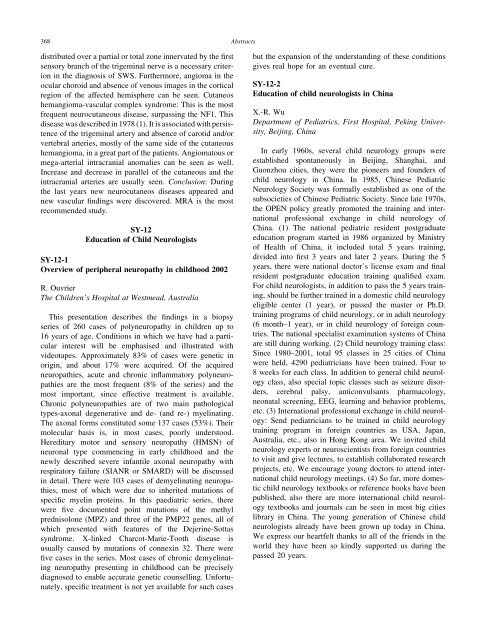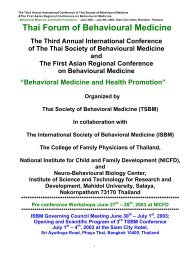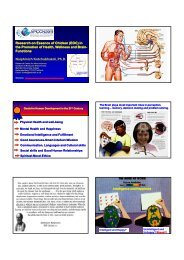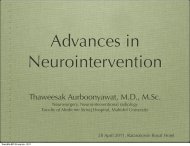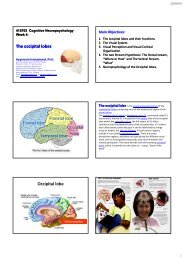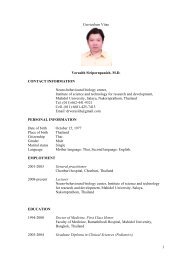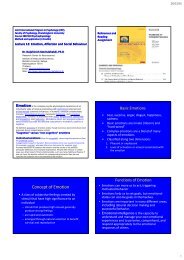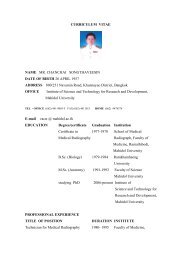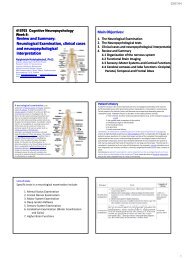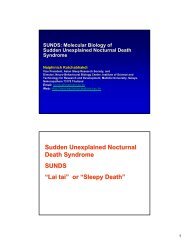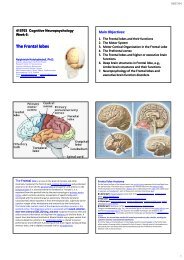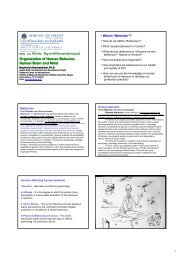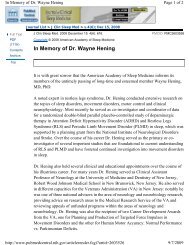PDF File - Mahidol University
PDF File - Mahidol University
PDF File - Mahidol University
You also want an ePaper? Increase the reach of your titles
YUMPU automatically turns print PDFs into web optimized ePapers that Google loves.
368<br />
Abstracts<br />
distributed over a partial or total zone innervated by the first<br />
sensory branch of the trigeminal nerve is a necessary criterion<br />
in the diagnosis of SWS. Furthermore, angioma in the<br />
ocular choroid and absence of venous images in the cortical<br />
region of the affected hemisphere can be seen. Cutaneos<br />
hemangioma-vascular complex syndrome: This is the most<br />
frequent neurocutaneous disease, surpassing the NF1. This<br />
disease was described in 1978 (1). It is associated with persistence<br />
of the trigeminal artery and absence of carotid and/or<br />
vertebral arteries, mostly of the same side of the cutaneous<br />
hemangioma, in a great part of the patients. Angiomatous or<br />
mega-arterial intracranial anomalies can be seen as well.<br />
Increase and decrease in parallel of the cutaneous and the<br />
intracranial arteries are usually seen. Conclusion: During<br />
the last years new neurocutaneos diseases appeared and<br />
new vascular findings were discovered. MRA is the most<br />
recommended study.<br />
SY-12<br />
Education of Child Neurologists<br />
SY-12-1<br />
Overview of peripheral neuropathy in childhood 2002<br />
R. Ouvrier<br />
The Children’s Hospital at Westmead, Australia<br />
This presentation describes the findings in a biopsy<br />
series of 260 cases of polyneuropathy in children up to<br />
16 years of age. Conditions in which we have had a particular<br />
interest will be emphasised and illustrated with<br />
videotapes. Approximately 83% of cases were genetic in<br />
origin, and about 17% were acquired. Of the acquired<br />
neuropathies, acute and chronic inflammatory polyneuropathies<br />
are the most frequent (8% of the series) and the<br />
most important, since effective treatment is available.<br />
Chronic polyneuropathies are of two main pathological<br />
types-axonal degenerative and de- (and re-) myelinating.<br />
The axonal forms constituted some 137 cases (53%). Their<br />
molecular basis is, in most cases, poorly understood.<br />
Hereditary motor and sensory neuropathy (HMSN) of<br />
neuronal type commencing in early childhood and the<br />
newly described severe infantile axonal neuropathy with<br />
respiratory failure (SIANR or SMARD) will be discussed<br />
in detail. There were 103 cases of demyelinating neuropathies,<br />
most of which were due to inherited mutations of<br />
specific myelin proteins. In this paediatric series, there<br />
were five documented point mutations of the methyl<br />
prednisolone (MPZ) and three of the PMP22 genes, all of<br />
which presented with features of the Dejerine-Sottas<br />
syndrome. X-linked Charcot-Marie-Tooth disease is<br />
usually caused by mutations of connexin 32. There were<br />
five cases in the series. Most cases of chronic demyelinating<br />
neuropathy presenting in childhood can be precisely<br />
diagnosed to enable accurate genetic counselling. Unfortunately,<br />
specific treatment is not yet available for such cases<br />
but the expansion of the understanding of these conditions<br />
gives real hope for an eventual cure.<br />
SY-12-2<br />
Education of child neurologists in China<br />
X.-R. Wu<br />
Department of Pediatrics, First Hospital, Peking <strong>University</strong>,<br />
Beijing, China<br />
In early 1960s, several child neurology groups were<br />
established spontaneously in Beijing, Shanghai, and<br />
Guonzhou cities, they were the pioneers and founders of<br />
child neurology in China. In 1985, Chinese Pediatric<br />
Neurology Society was formally established as one of the<br />
subsocieties of Chinese Pediatric Society. Since late 1970s,<br />
the OPEN policy greatly promoted the training and international<br />
professional exchange in child neurology of<br />
China. (1) The national pediatric resident postgraduate<br />
education program started in 1986 organized by Ministry<br />
of Health of China, it included total 5 years training,<br />
divided into first 3 years and later 2 years. During the 5<br />
years, there were national doctor’s license exam and final<br />
resident postgraduate education training qualified exam.<br />
For child neurologists, in addition to pass the 5 years training,<br />
should be further trained in a domestic child neurology<br />
eligible center (1 year), or passed the master or Ph.D.<br />
training programs of child neurology, or in adult neurology<br />
(6 month–1 year), or in child neurology of foreign countries.<br />
The national specialist examination systems of China<br />
are still during working. (2) Child neurology training class:<br />
Since 1980–2001, total 95 classes in 25 cities of China<br />
were held, 4290 pediatricians have been trained. Four to<br />
8 weeks for each class. In addition to general child neurology<br />
class, also special topic classes such as seizure disorders,<br />
cerebral palsy, anticonvulsants pharmacology,<br />
neonatal screening, EEG, learning and behavior problems,<br />
etc. (3) International professional exchange in child neurology:<br />
Send pediatricians to be trained in child neurology<br />
training program in foreign countries as USA, Japan,<br />
Australia, etc., also in Hong Kong area. We invited child<br />
neurology experts or neuroscientists from foreign countries<br />
to visit and give lectures, to establish collaborated research<br />
projects, etc. We encourage young doctors to attend international<br />
child neurology meetings. (4) So far, more domestic<br />
child neurology textbooks or reference books have been<br />
published, also there are more international child neurology<br />
textbooks and journals can be seen in most big cities<br />
library in China. The young generation of Chinese child<br />
neurologists already have been grown up today in China.<br />
We express our heartfelt thanks to all of the friends in the<br />
world they have been so kindly supported us during the<br />
passed 20 years.


